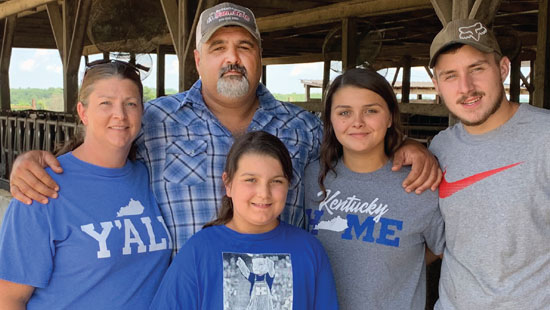
Members of the Ping family are, from left: Andrea, Adam, Brooklyn, and Haley Ping, along with Haley’s boyfriend, Jaden, who works full-time at the family’s dairy.
JUNE
On Dairy Month, who produces the best milk in Kentucky?
By Chris Aldridge
Kentucky Ag News
Adam Ping boasts that his dairy in northern Pulaski County has the best milk and the best dairy herd in Kentucky, and he has the hardware to back up his claims.
Ping Dairy near tiny Eubank, Ky., is the reigning winner of the Kentucky Dairy Development Council’s (KDDC) Highest Milk Quality Award. It also won the award in 2021 and several times before that.
The Pings also won the most recent Top Quality Herd Award given by the council last year, and five of the past six awards in that category. The only year they didn’t finish in first place in the state was when they placed runner-up in 2021.
Ping attributed all the awards to “keeping our cows clean and happy and cool under fans,” he said.
One of the biggest changes the Pings made was creating sand bedding for their herd in 2012, enhancing their environment and reducing bacteria in the milk.
“We had a lot of trouble in the pasture,” Ping said. “They (cows) would stomp under a big tree, make a mud puddle, and they’d all get in it. That’s where you get a lot of bacteria. Being under a roof in sand makes it (milk) a lot better.”
After the change, the Pings’ somatic cell count, which measures infection of the cows’ udders, averages 40,0000-60,000 for his 62 milk cows, consisting of mostly Holsteins and a few Jerseys. A count of 100,000 or less indicates an uninfected cow.
“I love it all,” Ping said of dairy farming. “I don’t exactly love getting up seven days a week at 4:30 (a.m.). After 21 years, that’s getting old.
“But I love working outside. I like to plow and till the land and plant. And I like to sit on my front porch and watch the corn grow.”
Ping farms about 250 acres in three tracts. He owns 80 acres and leases the rest, including the 100-acre family farm that he grew up on, owned by his mother.
“We raise most all of our sileage and hay,” Ping said of the feed for his 160 head of dairy cattle, including steers. “We try to rotate (feed) corn with soybeans when we can.”
Ping has been milking cows since he was 8 years old.
“I had an uncle right down the road, and I helped him milk – probably got in the way more than helped,” Ping said. “It just got in my blood.
“I remember the milk man coming to pick up our milk one day. He said, ‘Boy, you better stay away from here. This will get in your blood.’ He wasn’t lying.”
As Ping got older, he helped two other nearby dairy farmers milk their herds.
“I have another uncle five miles away that I helped,” Ping said. “I milked for another guy who had Jerseys, and I ended up buying his farm. That’s all I’ve ever done.”
Ping’s father, Gary, was a part-time farmer who raised beef cattle and tobacco.
“I talked my dad into helping me build the dairy,” Adam remembered. “When I got old enough to buy some heifers, that’s when we got into the dairy business.”
Adam married his high school sweetheart, Angela, an elementary school teacher, in 2001. They have two daughters – Haley, 18, and Brooklyn, 10.
“We were milking on our first anniversary,” Adam said. “It’s a family deal.
“My daughter (Haley) has been milking almost every morning for six months since she graduated in December from Pulaski County High School. She wants to go to college this fall and be a nurse. Her boyfriend, Jaden, has been helping me full-time for two years.”
The Pings milk their herd twice a day and consistently average about 75 pounds of milk daily, producing a rolling herd average of about 25,000 pounds. “We’re third in our district for production,” Adam noted.
“This time of year is a busy time,” he added. “My cows are calving, the hay needs to be cut, and the corn and beans need to be planted, all at the same time.”
Adam said the state of the dairy industry in Kentucky is improving.
“Since COVID, a lot of people got out, so milk prices have been real good,” he said. “The inputs are terribly high, but we’re doing all right. We’re not getting rich, but we’re not laying in bed worrying about it like we were.
“My personal opinion is nobody wants to work seven days a week, 24 hours a day anymore. I kind of worry about the future, especially small farms. If the dairy industry does survive, it’ll be huge mega dairies, like one with 5,000 head coming into western Kentucky from California.”
H.H. Barlow, a dairy farmer himself and executive director of the KDDC, has visited Ping Dairy. He called it “a great example of a family dairy.”
“It was a real joy to see a family work together for a common goal,” Barlow said, “and see the great success they have achieved while at the same time striving for excellence.”

